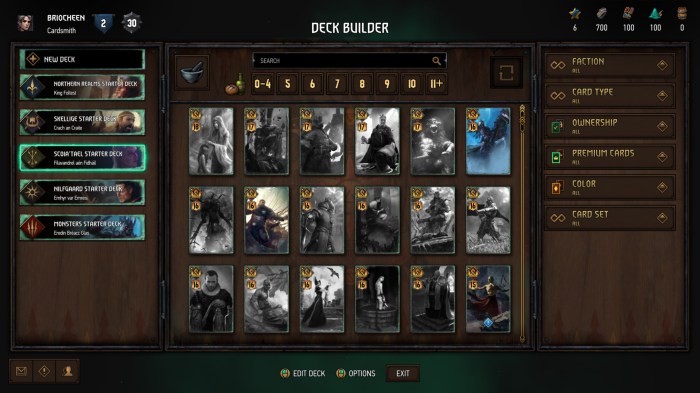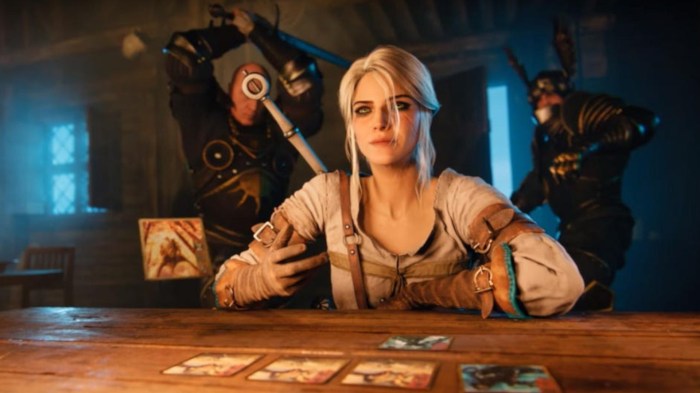Building a Gwent deck is an art form that requires a deep understanding of the game’s mechanics and a keen eye for strategy. In this comprehensive guide, we’ll delve into the intricacies of deck building, providing you with the knowledge and tools to create a deck that will dominate the battlefield.
From understanding the different card types and abilities to mastering the art of card interactions and combos, this guide will empower you to build a deck that is both powerful and cohesive. Whether you’re a seasoned Gwent veteran or a newcomer to the game, this guide will provide you with the insights and strategies you need to succeed.
Card Types and Abilities: Building A Gwent Deck

Gwent decks consist of different types of cards, each with unique abilities and mechanics. Understanding these card types is crucial for building an effective deck.
- Unit Cards:Represent characters or creatures with varying strength, abilities, and factions. They can be played in rows on the battlefield.
- Special Cards:Provide instant effects or manipulate the game state, such as summoning additional units, damaging opponents, or modifying card abilities.
- Weather Cards:Affect the entire row they are played on, causing negative effects to units of certain factions or providing bonuses to others.
- Hero Cards:Powerful units with unique abilities that can significantly impact the game. They can only be played once per match.
- Artifact Cards:Provide ongoing effects or bonuses to units in specific rows or factions. They remain on the battlefield until destroyed.
Faction and Leader Selection
Gwent features multiple factions, each with its own unique strengths, weaknesses, and playstyles. Choosing the right faction and leader is essential for maximizing your deck’s potential.
- Northern Realms:Known for their versatility, with a wide range of unit and special cards.
- Scoia’tael:Focuses on agility, mobility, and swarming the battlefield with numerous units.
- Monsters:Emphasizes raw strength, with powerful units and abilities that manipulate the battlefield.
- Nilfgaard:Relies on tactics and deception, with cards that control the opponent’s deck and abilities.
- Skellige:Known for their resilience and ability to generate cards and resources.
Each faction has multiple leaders, each with unique abilities that can enhance the faction’s playstyle.
Deck Building Strategies

Building a cohesive and effective Gwent deck requires a strategic approach. Here are some fundamental principles to consider:
- Synergy:Combining cards that complement each other’s abilities can create powerful combos and synergies.
- Card Ratios:Optimizing the number of cards of each type is crucial for consistency and maximizing your deck’s strengths.
- Card Advantage:Gaining an advantage in the number of cards played or resources generated can give you a significant edge.
Card Interactions and Combos
Understanding card interactions and combos is essential for maximizing your deck’s potential. Some powerful interactions include:
- Weather Manipulation:Using weather cards to damage or weaken opponent’s units while protecting your own.
- Unit Buffs:Combining cards that provide bonuses to units, such as increased strength or abilities.
- Control Effects:Using cards that manipulate the opponent’s deck or abilities, such as discarding cards or silencing units.
Effective card placement and sequencing are also crucial for maximizing combos and minimizing opponent’s counterplay.
Deck Customization and Refinement
Once you have a deck, analyzing its performance and making adjustments is crucial for improvement. Consider the following:
- Playtesting:Testing your deck against opponents or in practice mode to identify strengths, weaknesses, and areas for improvement.
- Meta Analysis:Studying the current meta and adapting your deck to counter popular strategies.
- Card Swapping:Experimenting with different card combinations to find the optimal balance and synergy.
Community and Resource Utilization

The Gwent community plays a vital role in deck building and strategy sharing. Utilize resources such as:
- Online Deck Builders:Tools that allow you to create and share decks with other players.
- Community Forums:Platforms for discussing deck strategies, sharing ideas, and getting feedback.
- Streamers:Watching skilled players stream their games can provide valuable insights and inspiration.
Frequently Asked Questions
What are the different types of cards in a Gwent deck?
There are six types of cards in a Gwent deck: units, specials, artifacts, leaders, tactics, and weather effects.
How do I choose the right faction for my deck?
Each faction in Gwent has its own unique strengths and weaknesses. Consider your playstyle and the cards you have available when choosing a faction.
What is the concept of synergy in deck building?
Synergy is the ability of cards to work together to create powerful effects. When building a deck, consider how the cards interact with each other and how you can maximize their combined strength.
